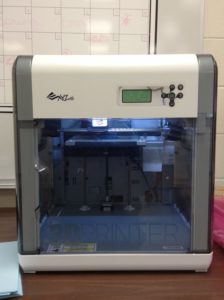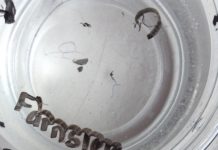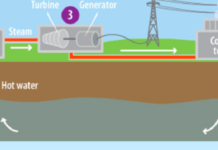by Eman Robele; Farnsley Middle School (Louisville, KY)
3D printing is one of the newest industries in the world. 3D printing, (also known as three-dimensional printing) is like inkjet printing but instead of getting a flat sheet of paper you get a three dimensional object.
According to Wohlers Report, in 2014, the worldwide 3D printing industry is now expected to grow from $3.07 billion in revenue in 2013, to $12.8 billion by 2018, and exceed $21 billion in worldwide revenue by 2020. The benefit to this rapid prototyping are maquettes (a sculptor’s model or sketch), healthcare, and entertainment.
According to 3dprintingindustry.com, 3D printing started in the 1980’s; Chuck Hull invented the process of stereolithography—a type of 3D printing used for model making. Later on, he founded one of the first 3D printing companies, Materialize. Now, 3D printers are being used in schools to expose students to the high level of technology (We have one in our school too). Even now, the new industry is so popular that it has its own national holiday, December 3rd (3D)!
3D printing can be used for creating simple and small projects for fun, to huge industrial printers that make parts for appliances and cars that cost thousands of dollars a year per license for software. There’s even a 3D printer on the International Space Station! Because of the wide range of materials, including plastic, metal or paper, it can be used to 3D print jewelry and toys that can be manufactured efficiently and promptly in mass amounts. 3D printing was also behind some of the biggest movies and shows like Star Wars and Game of Thrones. They used a type of printer with 3D printing software that allows movie producers to use this for character development and modeling.
In order to begin the process of developing a 3D project, you need to have an idea.
In an email to SciJourner, Jim Rodda—also known as Zheng₃, an expert in 3D printing living in Appleton, WI, USA—states that, “Pre-production is a good idea as it would save you ten minutes of modeling, hours of printing, and days of frustration.” Therefore, starting out by a simple sketch of your object would save you so much time for actually designing and printing.
Making your virtual design of the object you’re creating uses CAD or Computer Aided Design file, which is a 3D modeling application that can be used with a 3D scanner. There are multiple types of software that are open to anyone to use, like Blender and Tinkercad. According to 3dprinting.com, Tinkercad is the software recommended for newcomers to the craft.

The process of 3D printing is performed in different ways. 3Dprinting.com states that first step is to prepare it for printing, which is termed slicing. That means the object is divided into hundreds and thousands of layers. Then, the file is transferred to the printer via USB, SD, or Wi-Fi, which depends on the printer you have. Finally, the printer reads each 2D slice and prints it off layer-by-layer to create the 3-D object. It’s a long process but it’s worth it at the end.
There are seven diverse printing processes, Vat Photopolymerisation, Material Jetting, Binder Jetting, Material Extrusion, Directed Energy Deposition, Sheet Lamination and Power Bed Extrusion. Some use different materials or even a different way to distribute the material to form the 3D object. Each printing process is set for a different purpose or industry to be used for in. According to 3dprinting.com, they are usually categorized between two groups; SLS (Selective laser sintering), or FDM (fused deposition modeling). SLS uses a laser to fuse each particle together while FDM just disperses the material through a nozzle.
These are a few of the most common processes: Vat Photopolymerisation, Material Jetting and Binder Jetting.
Vat Photopolymerization is where the printer is filled with photopolymer resin (a polymer that reacts when exposed to light), which is later hardened with a UV light source.
Material Jetting is where the material is applied in droplets through a small diameter nozzle, similar to how a regular inkjet printer works. However, the material is applied layer by layer to build the 3D object, which is then hardened by a UV light.
There are two main materials used in binder jetting: powder-based material and liquid binder. The powder is spread into the equal layers, the binder is applied through a nozzle in order to make the powder stick and combine. Later, excess powder is cleaned off after the print.
Bioprinting is a new type of printing where, according to 3D printing.com, layers of living cells are being deposited into a gel form and slowly built up to form 3D structures like skin tissue. Things like working kidneys and skin are constructed from this operation; even bones are produced by this procedure.
In the aerospace and aviation industries, according to nasa.gov, NASA has printed combustion chamber liners using SLS. Not only that but SpaceX and Rocketdyne other programs by NASA have made some sort of 3D printed parts.
In March 2015, the FAA cleared GE Aviations first 3D printed jet engine to fly. GE engineers had also made a mini jet engine that goes up to 33,000 rotations per minute.
In the entertainment industry, some Hollywood movies had infused 3D printing for model making costumes for characters and to sketch out the overall looks of an animated figure or design. According to 3dprint.com, the 2016 movie, Star Wars: The Force Awakens, is filled with 3D printed props and parts of costumes.
The 3D Printer Pen is a new addition to the printer family is a lot similar to a hot glue gun. You “draw” the melted plastic, or whatever material you are using, comes out of the pen tip and layers out as you draw. Popular brands are Scribbler 3D, SketchPro and 3Doodler. Some YouTubers like 3D Pen Lab and Make Anything have posted videos on the pens and the printer.

This work is licensed under a Creative Commons Attribution-NonCommercial-NoDerivs 3.0 Unported License.













